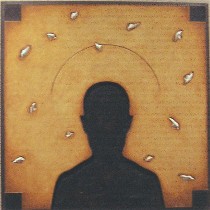 Anne Minich’s one-woman show at the Cathedral is perfectly sited among the stained glass windows in the towering space (right, “Judas Head”).
Anne Minich’s one-woman show at the Cathedral is perfectly sited among the stained glass windows in the towering space (right, “Judas Head”).“From the Head Series” presents anonymous, iconic heads against gridded or unpatterned backdrops, each painting/construction suggesting some form of suffering and each head crowned with a halo. The layered ochres and reds of so many of the paintings, the rich finishes, and the beautiful craftsmanship and attention to materials are as much a subject as the imagery.
Their magic is how they interlace the vocabulary of Minimalist corporate uniformity with a vocabulary of objects and icons and somehow reach the intensity of Medieval saints’ narratives.
Minich, whose name you may not know although she has been around for a long while, mostly shows in Maine — see Roberta’s post here–and was the 1994 Leeway Bessy Berman Grant winner for excellence in painting. Roberta’s post is the beginning of the tale of how this show came to be, but I’m short on the info, which will have to appear in another post on another day.
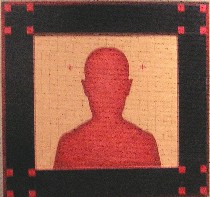 The gridded backdrops suggest mass-production anonymity of worker bees. The heads reinforce that anonymity–and universality–each head just a flat blank shape. It hardly matters who this suffering saint is. It’s not even clear whether the head is male or female. It’s just another over-worked, over-stressed disposable person in the production line of life and love.
The gridded backdrops suggest mass-production anonymity of worker bees. The heads reinforce that anonymity–and universality–each head just a flat blank shape. It hardly matters who this suffering saint is. It’s not even clear whether the head is male or female. It’s just another over-worked, over-stressed disposable person in the production line of life and love.
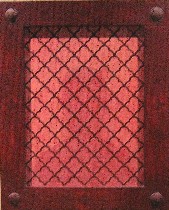 Not all the backdrops have grids. One has bricks. One has a fleur-de-lis grille pattern that looks Arabian (right). Another has interlocking crosses that remind me of brocaded clerical vestments (left above). All suggest life in compressed space–or a pressured mind. And some suggest domesticity, the pattern of wallpaper–and not. The patterns are mostly so austere, they undermine any notion of decoration. The painting, on the other hand, is not in the least austere, but layered and glorious.
Not all the backdrops have grids. One has bricks. One has a fleur-de-lis grille pattern that looks Arabian (right). Another has interlocking crosses that remind me of brocaded clerical vestments (left above). All suggest life in compressed space–or a pressured mind. And some suggest domesticity, the pattern of wallpaper–and not. The patterns are mostly so austere, they undermine any notion of decoration. The painting, on the other hand, is not in the least austere, but layered and glorious.
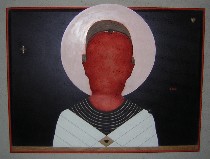 The suffering in these paintings is alleviated not only by the beauty, but by the wifty objects–shells, rocks, shards of clay, thorny objects, a small gold heart locket, a tiny gold cross. The objects become religious relics that are part of the drama in the paintings. This is the rock that pierced my skull forever. This is the shell of a heart. These are my crowns of thorns, my crowns of pain, my crowns of paint. Some people wear their shell of a heart on their sleeve. One head here wears the shells as a crown of glory (left, “Sad,” with a tiny gold cross on the left, a gold heart in the upper right corner, and a carved out stencil of a heart in the center, like a brooch).
The suffering in these paintings is alleviated not only by the beauty, but by the wifty objects–shells, rocks, shards of clay, thorny objects, a small gold heart locket, a tiny gold cross. The objects become religious relics that are part of the drama in the paintings. This is the rock that pierced my skull forever. This is the shell of a heart. These are my crowns of thorns, my crowns of pain, my crowns of paint. Some people wear their shell of a heart on their sleeve. One head here wears the shells as a crown of glory (left, “Sad,” with a tiny gold cross on the left, a gold heart in the upper right corner, and a carved out stencil of a heart in the center, like a brooch).
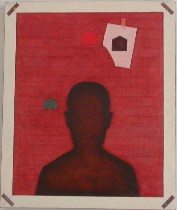 These may be Bleeding Heart paintings, but this is not true religion–one more reason it’s so great to see it hanging in a church. The dramatization of the suffering is borderline ironic. But it’s a tiny twinkle of humor.
These may be Bleeding Heart paintings, but this is not true religion–one more reason it’s so great to see it hanging in a church. The dramatization of the suffering is borderline ironic. But it’s a tiny twinkle of humor.
The exaggerated halos, out of their time and place, suggest both a relishing of pain and a triumph over it in the repetitive drama–as in how many paintings does it take to cure a broken heart. Minich lets it cut both ways, and ultimately, the beauty and discipline of the work wins the conflict, letting the paintings rise to some religious ecstasy of their own.
That tiny space of emotional distance and humor–and it is tiny because at the same time the paintings are so sincere–places the work as post-modern, even with the medieval references.
 Each painting, on wood, is framed in its own perfect setting. The head of “Our Lady of Francisville” (left) is screwed with three ordinary round-head screws onto a brick wall backdrop. The screws are a statement. The head rests on a narrow shelf, its molding bottom suggesting a fireplace mantle. “Our Lady of Three Houses” (right above) has a paper-like frame with what look like taped- together joints. These are careful and surprising decisions that bring me back to Duchamp and Magritte.
Each painting, on wood, is framed in its own perfect setting. The head of “Our Lady of Francisville” (left) is screwed with three ordinary round-head screws onto a brick wall backdrop. The screws are a statement. The head rests on a narrow shelf, its molding bottom suggesting a fireplace mantle. “Our Lady of Three Houses” (right above) has a paper-like frame with what look like taped- together joints. These are careful and surprising decisions that bring me back to Duchamp and Magritte.
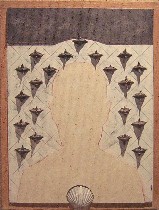 Looking at this show and reading about that smarty-pants Earl Bronsteen (see post,) I of course come down on the side of Minich, who has nurtured her art and thought processes over so much time, stepping out onto her own limb of artistic logic. This brings to mind something supposedly said by Richard Serra (well, Chuck Close said it was Serra) about an artist needing to take a series of roads that go in a different direction from where the crowd is going, until the crowd is lost and the artist is where noone else has gone before. That’s where Minich is (right, the crown of thorns in this painting remind me of a wimple and a mantilla).
Looking at this show and reading about that smarty-pants Earl Bronsteen (see post,) I of course come down on the side of Minich, who has nurtured her art and thought processes over so much time, stepping out onto her own limb of artistic logic. This brings to mind something supposedly said by Richard Serra (well, Chuck Close said it was Serra) about an artist needing to take a series of roads that go in a different direction from where the crowd is going, until the crowd is lost and the artist is where noone else has gone before. That’s where Minich is (right, the crown of thorns in this painting remind me of a wimple and a mantilla).
Minich’s command of materials and her original use of them are alone worth the trip to the Cathedral, at 38th and Chestnut. The show runs until Oct. 10, hours 10 a.m. to 4 p.m. Monday to Friday, or by appointment, 215 386-0234.









